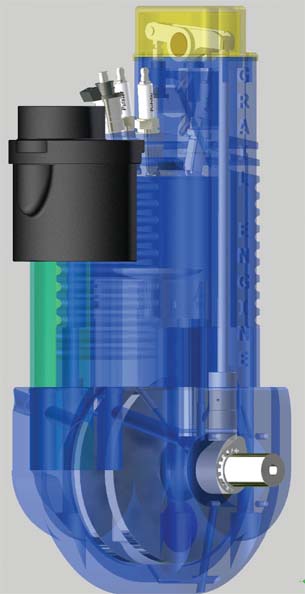Rethinking the Internal Combustion Engine with Autodesk Inventor 2010
Designs that Will Change the World, Second Place: In an age in which so many are advocating the demise of the internal combustion engine, Grail Engine Technologies' design team wants to make it better.
Latest News
December 1, 2009
By Tom Kevan
 The Grail Engine’s design team used Autodesk Inventor 2010 extensively, which allowed the engineers to develop a completed, constrained, and animated 3D assembly model in 19 weeks. |
The irony of so many of humankind’s solutions to problems is that they introduce new, unforeseen problems of their own. Consider those who propose reducing or eliminating the negative effects of the internal combustion engine by expanding the use of batteries. Sounds good at first blush, but what happens to the batteries at the end of their operational life? Do they end up in a landfill? Would we be replacing one problem with another?
Grail Engine Technologies decided it would be better to improve the internal combustion engine than to replace it, and began its design process in April 2009. The result is a state-of-the-art two-stroke engine that achieves morethan 100 mpg—improving fuel efficiency 50 percent over current vehicles—while extensively reducing exhaust emissions. The power plant operates on multiple types of fuels, including biodiesel, ethanol, gasoline, alcohol-based fuels, propane, methane, hydrogen, and natural gas, and reduces the production cost of automobiles.
The Design Team
Matthew Riley, Grail’s CEO and chief research scientist, developed the original engine concept. He was joined by Nicholas Bennington, Grail’s president and chief engineer, and the two did the initial steps of the design. Between the two, they had expertise in the fields of internal combustion engine design, ignition systems, and emissions technology. Then, with the aid of the CAD Department of the Salina Area Technical College, Riley and Bennington refined the design.
The Grail team’s primary design tool was Autodesk Inventor 2010. By using its tools, the engineers were able to move from the initial design to a completed constrained and animated 3D assembly model in 19 weeks. The Autodesk Inventor suite of tools enabled them to optimize the engine’s weight and flow characteristics, as well as perform stress analysis and reduce bill of material costs. The design team also used stereolithography rapid manufacturing tools to identify design issues, make form-fit and function changes, and visualize flow conditions of the engine.
The Engine
The Grail two-stroke engine consists of a single exhaust valve, three spark plugs, and a direct fuel injector—all located at the top of the cylinder; a single intake valve located within the piston; a pre-compression chamber that houses a one-way reed valve; two vent-to-piston ports; two piston-intake ports attached to the piston that travel within the vent-to-piston ports; and a crank case with minimized volume. As a result, most of the compression takes place within the pre-compression chamber, vent-to-piston ports, and piston intake ports.
Fresh air enters the external pre-compression chamber, vent-to-piston ports, and piston-intake ports via the one-way reed valve, as the piston travels upward in the cylinder. Compression occurs within the combustion cylinder as the piston travels upward. At the piston’s top dead center position, direct ignition and multiple ignition occurs, forcing the piston downward in the combustion cylinder, compressing air in the engine crankcase, external pre-compression chamber, vent-to-piston ports, and piston-intake ports.
Just prior to the piston reaching the bottom dead center (BDC) position, the exhaust valve opens via a standard cam-rod mechanism. Exhaust gases are expelled with pre-compressed fresh air via the piston valve and piston-intake ports. As the piston moves past the BDC position, the exhaust valve closes, and the cycle repeats.
Adjusting the volume within the external pre-compression chamber via a servomotor or an equivalent allows you to control engine outputs and efficiency at multiple engine speeds.
The Grail two-stroke engine can also simultaneously use the Miller cycle and homogeneous charged compression ignition. Because of this, the engine achieves excellent, clean, and efficient performance, which Grail claims is unmatched by any other engine on the market, at half the manufacturing cost.
The Impact
The Grail engine’s ability to deliver significantly better mileage, reduce fuel consumption and emissions, and cut automobile production costs holds much promise.
One of the most intriguing aspects of the design is its ability to use multiple types of fuel, but the absence of the infrastructure necessary to support extensive use of some of these types of fuel, such as hydrogen, is the main obstacle to the engine’s having a major impact on the world. If the supporting infrastructure becomes a reality, the improvements offered by the Grail Engine could have far-reaching effects. But for the near term, developing the infrastructure seems to be a big if.
More Info:
Autodesk Inc.
Contributing Editor Tom Kevan is based in New Hampshire and is DE’s mechatronics, PLM, and systems expert. Send your comments about this article to [email protected].
Subscribe to our FREE magazine, FREE email newsletters or both!
Latest News
About the Author
DE’s editors contribute news and new product announcements to Digital Engineering.
Press releases may be sent to them via [email protected].






